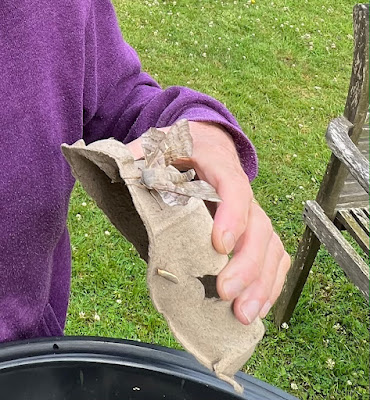
In one of those coincidences which are actually not random, two friends have separately sent me pictures of Jersey Tiger moths, one in a garden in built-up Walthamstow and the other in what its finder aptly describes as 'the rather brutal surroundings of Reading station car park'. The moth strayed North in the early 1990s from the Channel Islands where it has long been common and has since flourished in the South of England with - and I may proudly quote from the Moth Bible - 'occasional records elsewhere north to Leeds (one in 2008)'.
We lived in Leeds then and have a photo of a Jersey Tiger outside our greenhouse, taken not long before ID-ing another one spotted by my younger sister on holiday in Lyme Regis. We also saw masses by a waterfall on holiday in Turkey 20 years ago; the species is the one which forms a famous spectacle in season at the 'Valley of the Butterflies' in Rhodes.
The best I have seen, though, were at Kardamyli at the top of the Mani peninsular in the Peloponnese. They kindly allowed me to photograph their even more spectacular underwings which glowed orange in the bright sunshine of Greece.
One of my correspondents was startled that his find was a moth not a butterfly, understandably because like the more common Scarlet Tiger, the Cinnabar and the Burnet moths, Jersey Tigers are both brightly-coloured and day-flying. But somehow, I cannot see the Greek tourist authorities acknowledging their mistake as graciously as he did. There would be less interest, sadly, in a Valley of the Moths.
I've often featured the Yellowtail but can't resist posting more pictures of it, partly because the shenanigans of chasing or tickling it into showing the reason for its name are so enjoyable. This one led me and a friend who was very keen to see the tail from one perch to the next. Finally, above and below, it gave us a glimpse.
Here it is at rest in its usual pose, below, hiding the yellow but with the small brown smudges which distinguish it from the similar White Satin. While we're in the white and yellow part of the spectrum, here's one my top favourite flowers in the garden, a giant, floppy fried egg of a Romneya poppy, complete with worshipping hoverflies. Update: very many thanks to Conehead in Comments below for revealing to me that these are Marmalade Hoverflies. I never knew that such delightfully-named creatures existed.
Then take a look at the sulphurous yellow of this Brimstone, with the tiny specs of glorious orange on each wing. I was lucky to get a photo of the topwings though the reason was more melancholy, the poor butterfly had either been hit by a car or crash-landed because of the slipstream. It was on the tarmac right at the edge of the road as I biked past, still alive and feebly moving but very battered.
Here are a couple of Brimstones in the garden recently, showing their inevitable resting position with the wings tightly furled and the resemblance to a leaf remarkable.
I can't resist adding the two other primary colours in the form of flowers - chicory or Ragged Sailors, or Corn Dog or many other things, which is another of my top ten, and the glorious poppies which are everywhere round here for an awful lot of the Summer.
Finally, some other small neighbours. The Soldier Beetles are running wild with lust on our nettles and hogweed, a curiously portly little wasp has been buzzing around Update: thanks to Conehead in comments again, this is actually a 'Batman' Hoverfly, nick-named on account of its thorax emblem; its official name is Myathropa florea; then a great-niece found this pupa tucked neatly into a drystone wall, a Lacewing and a Small Red-eyed Demoiselle (No - Final update from the inexhaustibly knowledgable Conehead: this is actually a White-legged Damselfly as in C's comment below) vie for delicacy and I've even included a humble fly because of its perch on Elfrida, the calm stone goddess who oversees our garden.






















































